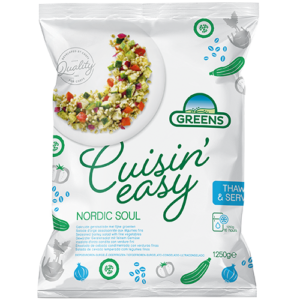The UK frozen food market resumed growth in the first quarter of 2023, according to data from British Frozen Food Federation (BFFF) and Kantar. Volume sales increased by 2,572,000 tons in the 12 weeks through March 19, compared to the same period last year. Similarly, the value of retail frozen food sales also advanced during this time, rising by 9.5% (£273,061,000). This was driven largely by inflation across the whole food chain.
Frozen vegetables, along with meat and poultry, potato products, ready meals and savory foods, have all experienced increases in volume sales during the first quarter, while ice cream and confectionery recorded a drop in sales volume in the same period.
For the first three-month period of the year, Kantar also reported a decrease of 5% in the volume sales of fresh and chilled food, as people turn to frozen products to help their budgets stretch through the cost-of-living crisis.
“I am delighted to see that the frozen food market has returned to growth in the first quarter of 2023,” said Rupert Ashby, chief executive of the BFFF. “Our members have been working incredibly hard under huge pressure of rising costs to make sure that consumers can still find the best quality products.”

Vegetable Growth
The frozen vegetable market is looking particularly healthy, with Mordor Intelligence predicting a global compound annual growth rate of 4.24% for the sector between 2021 and 2026. The Hyderabad, Telangana, India-based market research and advisory firm has attributed the success within this sector to a number of variables, which includes rapid urbanization, technological advances, demand for convenience and lockdown limitations during the Covid-19 pandemic.
“The rapid pace of urbanization, especially in the developing economies, coupled with growing disposable income and rising influence, has allowed convenience products to take center stage with regard to different fruits and vegetables. Altering technological advancements, along with aesthetic packaging, ease of storage, and all-around availability are boosting the demand for frozen vegetables. The presence of well balanced cold chain solutions and connected retail outlets have led to dramatic sales of the market, where most of the product portfolios are largely catered by local mid-and small-sized farms,” reports Mordor. “This segment is gaining popularity as a preferred alternative to fresh, canned and cooked food and healthy snack options among the millennial populations in the market.”
The coronavirus outbreak that spread from Wuhan, China to infect virtually the entire world further boosted frozen vegetable sales as consumers recognized the high retention of nutrients contained in products that could be kept at home for use as needed many weeks and months after purchase. Additionally, the fact that buying frozen food meant less trips out was also very appealing at this time.
“Research has proven that frozen vegetables retain more nutrients than their ‘fresh’ equivalents,” pointed out Ashby. “Spinach loses 75% of its vitamin C content two days after picking. This loss is reduced to 20% when spinach is frozen. It’s the same across the board for all frozen vegetables. When food is frozen as soon as it has been picked or prepared, all of its freshness is locked in, without the need for additives or preservatives.”
Despite the pandemic’s significant impact on cold chain supply, the subsequent consumer buying patterns, which focus more on health, have helped the frozen vegetable market develop faster than expected.
Convenience Food
Young professionals in the United Kingdom and elsewhere are increasingly searching for products that can be safely stored for an extended time period and be eaten with little preparation. Frozen vegetables fit the bill perfectly. Demand for convenient meal solutions among time-pressured consumers has witnessed a continuous increase in Europe, which is pushing the market growth of frozen vegetables.
According to Mordor Intelligence, Europeans tend to mirror the food trends of North Americans. Increasing spending on eating out will further boost the revenues in the European frozen vegetable market.
“Consumers in the region are becoming inclined toward vegan and healthy food as a part of lifestyle change. There has been a considerable shift from high-fat food products to low-fat and high-protein vegetables and fruits. Hence, this is boosting the market growth,” according to Mordor.

Frozen Vegetable Trends
When it comes to vegetable products, there has been a lot of innovation over the last few years, as evidenced in Birdseye’s Steamfresh range, which includes veggie-packed rice and pasta dishes.
“Innovation is at the heart of the frozen food market, with exciting new products regularly hitting supermarket freezer shelves,” said Ashby. “I am always impressed with the products which are being brought to the market by our members. The recent BFFF Awards shone a light on vegetarian dishes with Heron Foods’ Indian Essence Vegetable Tikka Masala taking bronze in the retail Best New Ready Meal category, and Greens Cuisin’easy Nordic Soul winning the Best New Meat Free Product by d’Arta in the foodservice category.”

He continued: “Beyond this, the constant development of potato products never fails to amaze me. In recent months we’ve seen new shapes and flavor variations of chips and fries including triple-cooked beef dripping chips, hash brown stars and brand extensions where popular snacks like Hula Hoops and Space Raiders have been transformed into frozen potato products.”

It’s little wonder that the frozen vegetable products sector is doing so well, given consumer demand for convenient, nutritious and cost effective food options. As the trajectory of home eating and shopping habits is set to continue along the same path, this sector will continue to grow as increasing numbers of consumers make the switch to frozen.





